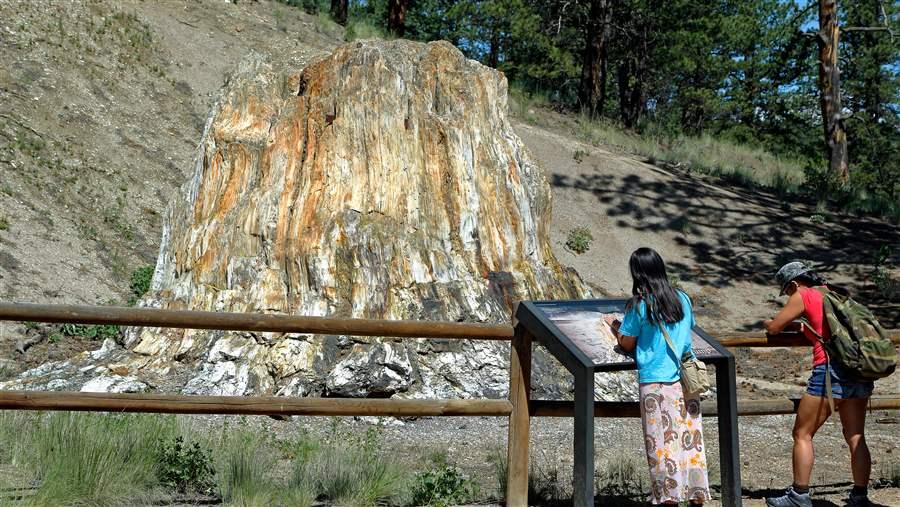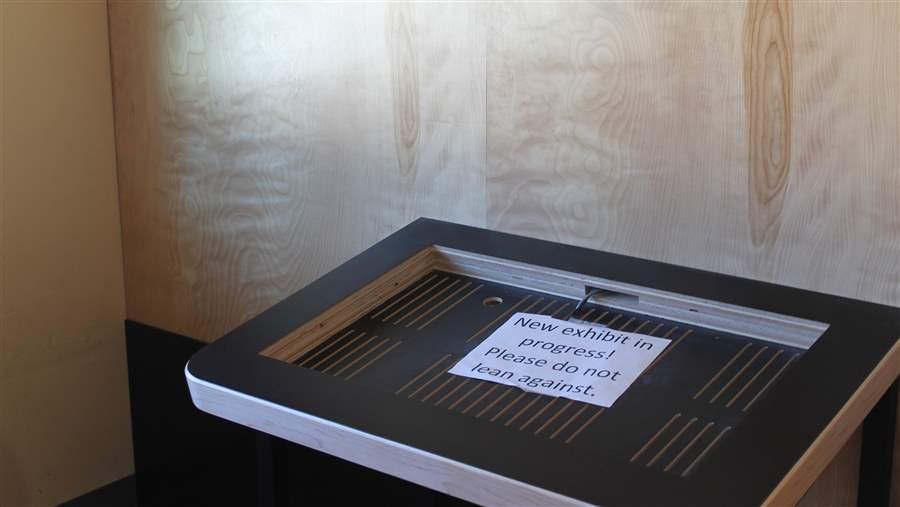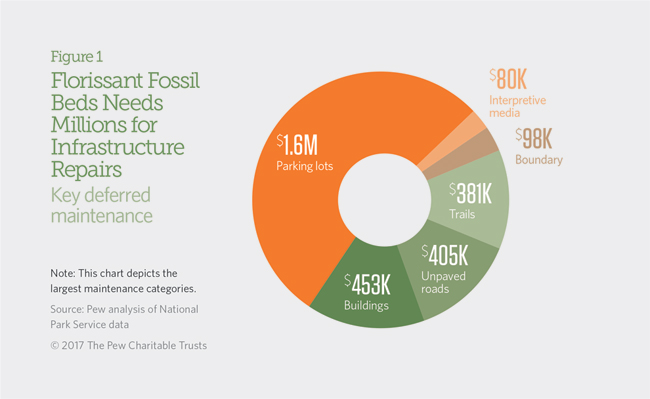Florissant Fossil Beds National Monument
Colorado

Park visitors can walk among petrified stumps of redwoods, the ancestors of today’s giants in California, or view fossils quarried at the site in the visitor center.
© Efrain Padro/ Alamy Stock PhotoPew created this case study using National Park Service deferred maintenance data issued in fiscal year 2015. The information listed here may no longer reflect the NPS site’s current condition or maintenance requirements. To find the most up-to-date information, please use the National Park Repair Needs tool.
Overview
Like other national parks, Florissant Fossil Beds National Monument in central Colorado has picturesque vistas. But its real treasure is underground: The 6,000-acre park has one of the world’s richest troves of plant and insect fossils. The well-preserved flowers, leaves, bees, and other insects discovered here help scientists understand how flowering plants evolved. They also tell the story of how America’s climate and ecosystems have changed over 30 million years. Park visitors can walk among petrified stumps of redwoods, the ancestors of today’s giants in California, or view fossils quarried at the site in the visitor center.
Unfortunately, more than $3 million in overdue repairs can make it difficult for visitors to view these unique finds.

Nearly $80,000 is needed for interpretive media displays at Florissant Fossil Beds National Monument, a small part of its $3.1 million maintenance backlog.
© The Pew Charitable TrustsMaintenance challenges
The park’s maintenance backlog is not unique. Many smaller National Park Service (NPS) sites are affected by the agency’s $11.3 billion in deferred maintenance. The infrastructure projects at Florissant Fossil Beds National Monument are necessary to improve safety, ensure access to people of all ages and abilities, and provide a high- quality experience that connects visitors to the park’s unique natural and cultural attractions.
Florissant Fossil Beds’ largest infrastructure project is a $1.6 million initiative to expand visitor parking to alleviate overcrowding. Inside the park, an access road was washed out by a storm and must be repaired. To help keep visitors safe, improvements such as increased signage, traffic humps to discourage speeding, new sidewalks, and better parking lot lighting are also needed. And just under $5,000 is required to maintain septic and bathroom facilities and replace recycling and trash containers.
The trails need work, too. Nearly $400,000 is required to repair the Petrified Forest, Hornbek Wildlife, Ponderosa, and Shootin’ Star loop trails. These 0.5- to 4-mile loops allow beginning hikers to view the park’s highlights, including the petrified redwood stumps. Funds are sought to remove trees that have fallen across the paths, repair washouts, improve drainage culverts, repair bridges, and remove encroaching vegetation. Upgrades to many trails, including the wheelchair-accessible Ponderosa Trail, will help fulfill the NPS’ mission to make the parks accessible and enjoyable for all visitors. A new “walk through time” trail will be fully compliant with the Americans with Disabilities Act and include accessible picnic facilities where it meets the visitor’s center.
An additional $80,000 is needed to fix broken, rotting, and weather-damaged signs and interpretive displays throughout the park. The new signage will educate visitors on everything from how fossils at the site provide evidence for a changing climate to how Colorado’s ancient volcanoes formed the rocks visitors stand on.
Funds are also sought to better protect park assets. This includes changing locks, installing intruder and fire alarm systems and rodent control devices, and upgrading gates and fencing. The park has also put on hold preventive maintenance projects such as filling woodpecker holes in the historic Hornbek Homestead log house with oakum.
Florissant Fossil Beds draws thousands of young families, adults, seniors, and singles to our area to visit its unique offerings. And by spending more than $4 million annually in nearby communities, visitors spark economic activity in the area.Debbie Miller, president, Greater Woodland Park Chamber
Recommendations
To address the infrastructure needs at Florissant Fossil Beds and other NPS sites in Colorado and across the country, Congress should:
- Ensure that infrastructure initiatives include provisions to address park maintenance.
- Provide dedicated annual federal funding for national park repairs.
- Enact innovative policy reforms to ensure that deferred maintenance does not escalate.
- Provide more highway funding for NPS maintenance needs.
- Create more opportunities for public-private collaboration and donations to help restore park infrastructure.
Florissant Fossil Beds National Monument Facts
2016
| Visitor spending | $4.3 million |
| Jobs created by visitor spending | 65 |
| Economic output | $6.3 million |
| Labor income | $2.4 million |
| Visits | 73,564 |
| Deferred maintenance (fiscal year 2015) | $3.1 million |
Sources: National Park Service, “Annual Visitation Report by Years: 2006 to 2016,” accessed June 14, 2017, https://irma.nps.gov/Stats/ SSRSReports/National%20Reports/Annual%20Visitation%20By%20Park%20(1979%20-%20Last%20Calendar%20Year); National Park Service, “Visitor Spending Effects,” accessed June 14, 2017, https://www.nps.gov/subjects/socialscience/vse.htm; National Park Service, “NPS Deferred Maintenance Reports,” accessed Aug. 19, 2016, https://www.nps.gov/subjects/plandesignconstruct/defermain.htm
© 2017 The Pew Charitable Trusts

The Pew Charitable Trusts works alongside the National Parks Conservation Association, the National Trust for Historic Preservation, and other national and local groups to ensure that our national park resources are maintained and protected for future generations to enjoy.













